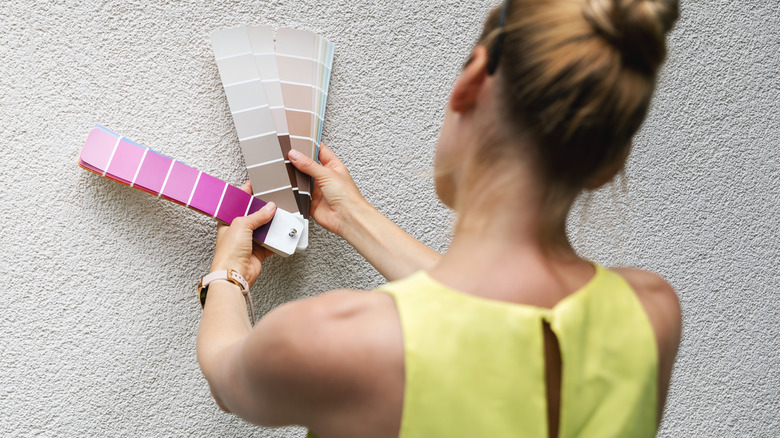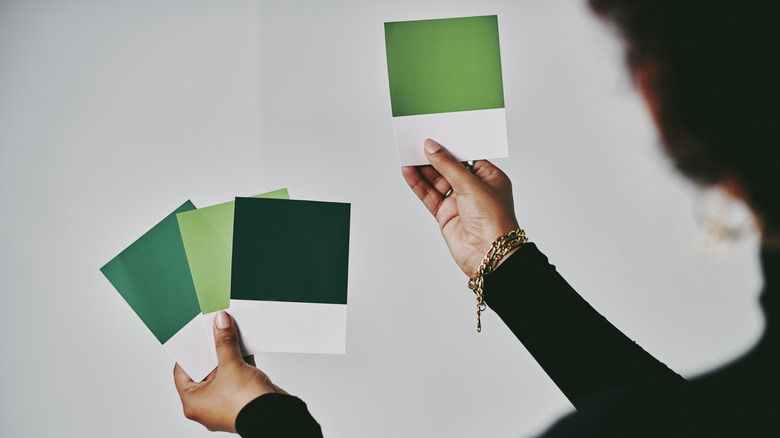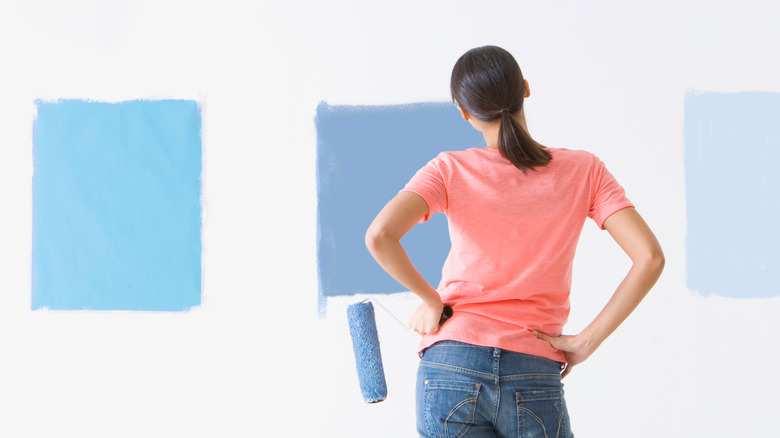The Common Paint Swatch Testing Method That Everyone Gets Wrong
Deciding to paint or repaint your home's walls is one of the most exciting times in interior design, but, according to a poll shared by Yahoo!, roughly 15% of Americans regret their paint color choices. After all the thinking and planning, when you finally get to enter the paint color aisle, you may feel mesmerized by the display of paint colors. While it's tempting to stuff a dozen paint swatches into your pockets, these paper color cards may not actually be the best method for settling on a wall color that you'll love long-term.
Holding your paint swatches up or taping them on the wall isn't a good way to fully absorb the undertones or understand the impact they'll have in the room. That's because your perception will be influenced by the swatches' size, the lighting, location, and any background colors in the room. If you've ever spent hours deciding on a paint color, only to discover that the final product isn't what you expected, it could be because you relied too heavily on paint swatches. Here's why holding paint swatches against the wall isn't such a good idea, what you can do to find your perfect shade instead.
Swatches are too small to see the big picture
There are a few reasons why paint swatches aren't an accurate tool for deciding your wall color. First and foremost, many are simply too small to help you pick the perfect shade of paint. The color may look fascinating and unique in a small square, but would it be too overpowering or too boring on a whole wall? It can be hard to tell when you only have a few square inches to estimate with, and the color will inevitably come out slightly different than you expected.
Most importantly, however, the small size of paint swatches means they will be easily overwhelmed on your wall. No matter how unbiased you try to be, the existing color of your wall may impact your feelings about the color, pushing you towards a choice that may not be best for your vision of the space. In addition to the base wall color, the small size of the swatches can be overshadowed by pre-existing furniture, lighting, reflections, and textures in the room. The same goes for placing the samples themselves too close together, which Farrow & Ball's brand ambassador Patrick O'Donnell told Real Simple, "will distract each other (and you!) and make it harder to make a clear choice."
Go big for your home
As you're browsing the paint aisle, it's still a great idea to gather a few color swatches and bring them home with you. Use them to narrow down your options, but never base your final decision on a swatch alone. Instead, purchase a sample jar of your few favorite colors and paint portions of the wall. "If you don't want to paint the area directly, paint the length of a large sheet of lining paper," Patrick O'Donnell recommended to Real Simple, "it becomes a movable feast that you can see on different walls in the same room and at different times of the day!" You can also consider ordering large paint swatches or peel-and-stick paint samples, or try using an app or computer program. If you decide to paint directly on the wall, be sure to fan out the edges of your paint samples — don't just paint perfect blocks, which may create a raised section underneath your final paint color.
But don't throw out your paint swatches once you've purchased your sample jars! You can still use them to create an inspired décor mood board and establish a color palette. Hang on to your mini paint swatches and bring them with you when you go shopping for furniture and décor. This will help you pick new items that compliment your fresh wall color.


